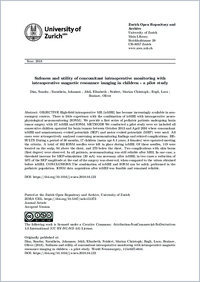Safeness and Utility of Concomitant Intraoperative Monitoring with Intraoperative Magnetic Resonance Imaging in Children: A Pilot Study.
- Dias S Clinical Neuroscience Center, Department of Neurosurgery, University Hospital Zurich, University of Zurich, Zurich, Switzerland. Electronic address: sandra.dias@usz.ch.
- Sarnthein J Clinical Neuroscience Center, Department of Neurosurgery, University Hospital Zurich, University of Zurich, Zurich, Switzerland; Zurich Neuroscience Center, ETH, Zurich, Switzerland.
- Jehli E Clinical Neuroscience Center, Department of Neurosurgery, University Hospital Zurich, University of Zurich, Zurich, Switzerland.
- Neidert MC Clinical Neuroscience Center, Department of Neurosurgery, University Hospital Zurich, University of Zurich, Zurich, Switzerland.
- Regli L Clinical Neuroscience Center, Department of Neurosurgery, University Hospital Zurich, University of Zurich, Zurich, Switzerland.
- Bozinov O Clinical Neuroscience Center, Department of Neurosurgery, University Hospital Zurich, University of Zurich, Zurich, Switzerland.
- 2018-05-01
Published in:
- World neurosurgery. - 2018
Complications
Intraoperative MRI
Intraoperative neurophysiological monitoring
Adolescent
Brain Neoplasms
Child
Child, Preschool
Evoked Potentials, Somatosensory
Female
Humans
Intraoperative Neurophysiological Monitoring
Magnetic Resonance Imaging
Male
Patient Safety
Pilot Projects
Prospective Studies
English
BACKGROUND
High-field intraoperative magnetic resonance imaging (MRI) has become increasingly available in neurosurgery centers. There is little experience with combined intraoperative MRI and intraoperative neurophysiologic monitoring (IONM). We report the first series, to our knowledge, of pediatric patients undergoing brain tumor surgery with 3T intraoperative MRI and IONM.
METHODS
This pilot study included all consecutive children operated on for brain tumors between October 2013 and April 2016 in whom concomitant intraoperative MRI and somatosensory evoked potentials and motor evoked potentials were used. Neuromonitoring findings and related complications of all cases were retrospectively analyzed.
RESULTS
During a 30-month period, 17 children (mean age 8.4 years; 3 girls) undergoing surgery met the study criteria. During intraoperative MRI, 483 IONM needles were left in place. Of these needles, 119 were located on the scalp, 94 were located above the chest, and 270 were located below the chest. Two complications with skin burns (first degree) were observed. In all patients, neuromonitoring was still reliable after MRI. In 1 case, a threshold increase for motor evoked potential stimulation (20 mA) was necessary after intraoperative MRI; in 2 cases, a reduction of 50% of the somatosensory evoked potential amplitude at the end of the surgery was observed compared with the values obtained before intraoperative MRI.
CONCLUSIONS
The combination of intraoperative MRI and IONM can be safely used in pediatric patients. IONM data acquisition after intraoperative MRI was feasible and remained reliable.
High-field intraoperative magnetic resonance imaging (MRI) has become increasingly available in neurosurgery centers. There is little experience with combined intraoperative MRI and intraoperative neurophysiologic monitoring (IONM). We report the first series, to our knowledge, of pediatric patients undergoing brain tumor surgery with 3T intraoperative MRI and IONM.
METHODS
This pilot study included all consecutive children operated on for brain tumors between October 2013 and April 2016 in whom concomitant intraoperative MRI and somatosensory evoked potentials and motor evoked potentials were used. Neuromonitoring findings and related complications of all cases were retrospectively analyzed.
RESULTS
During a 30-month period, 17 children (mean age 8.4 years; 3 girls) undergoing surgery met the study criteria. During intraoperative MRI, 483 IONM needles were left in place. Of these needles, 119 were located on the scalp, 94 were located above the chest, and 270 were located below the chest. Two complications with skin burns (first degree) were observed. In all patients, neuromonitoring was still reliable after MRI. In 1 case, a threshold increase for motor evoked potential stimulation (20 mA) was necessary after intraoperative MRI; in 2 cases, a reduction of 50% of the somatosensory evoked potential amplitude at the end of the surgery was observed compared with the values obtained before intraoperative MRI.
CONCLUSIONS
The combination of intraoperative MRI and IONM can be safely used in pediatric patients. IONM data acquisition after intraoperative MRI was feasible and remained reliable.
- Language
-
- English
- Open access status
- green
- Identifiers
-
- DOI 10.1016/j.wneu.2018.04.123
- PMID 29709735
- Persistent URL
- https://roar.hep-bejune.ch/global/documents/155133
Statistics
Document views: 18
File downloads:
- fulltext.pdf: 0
